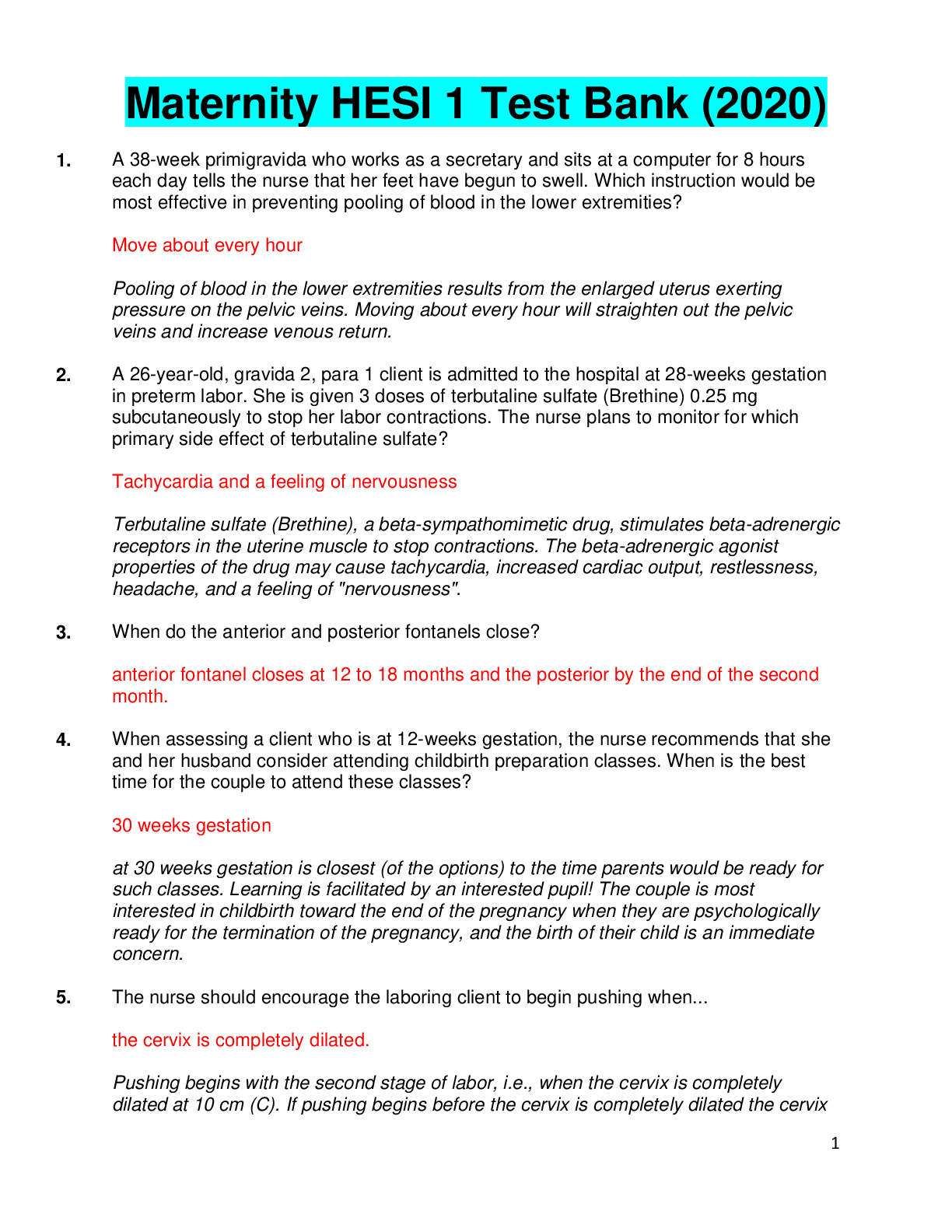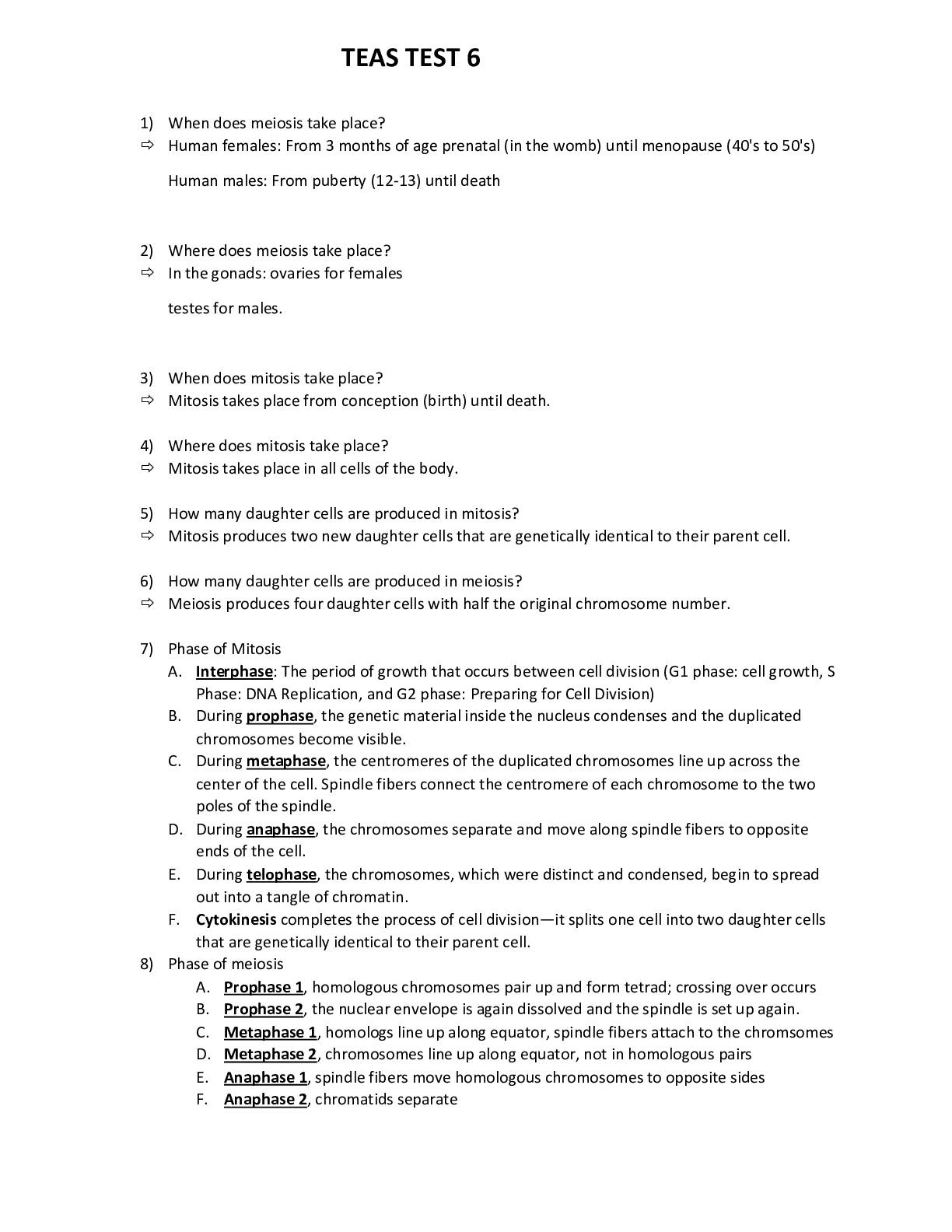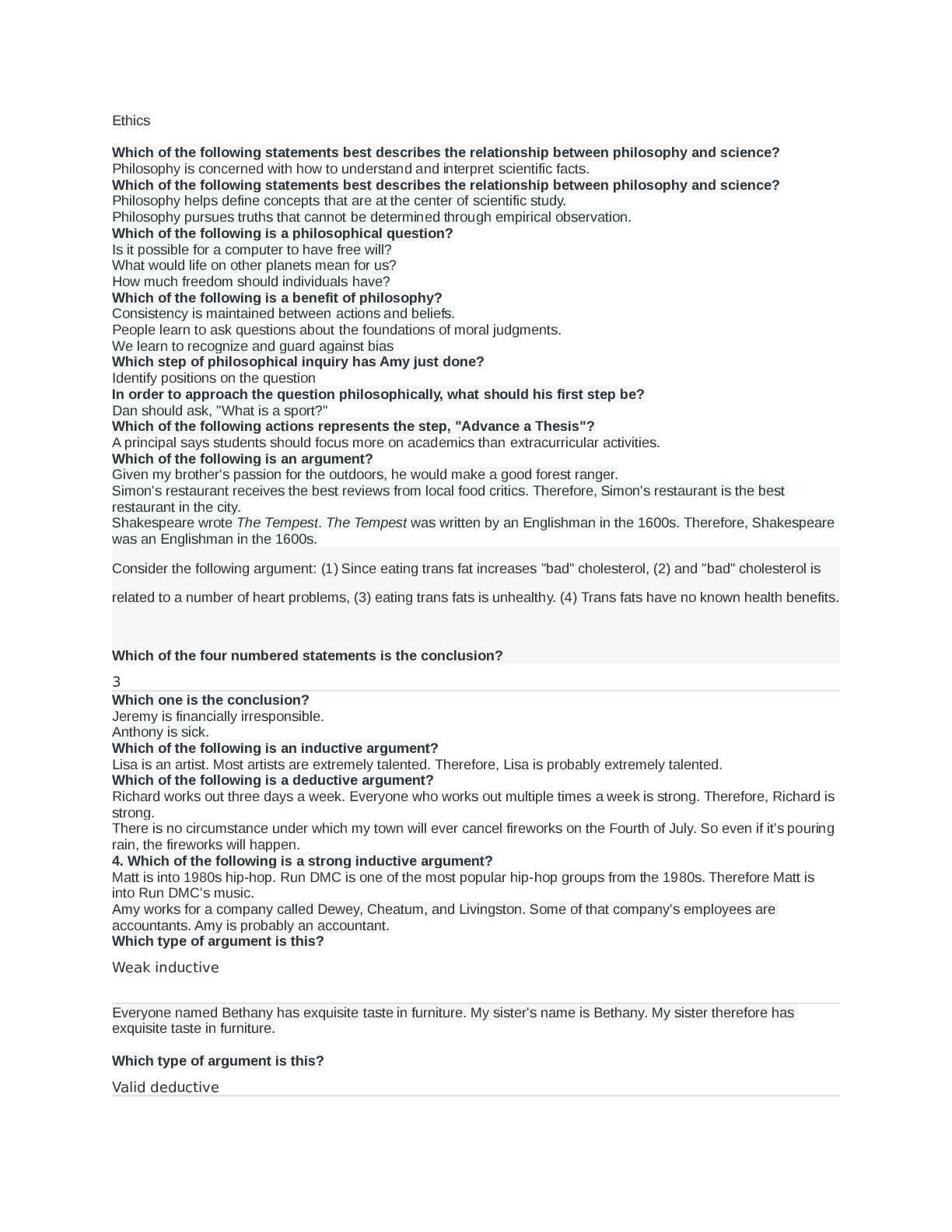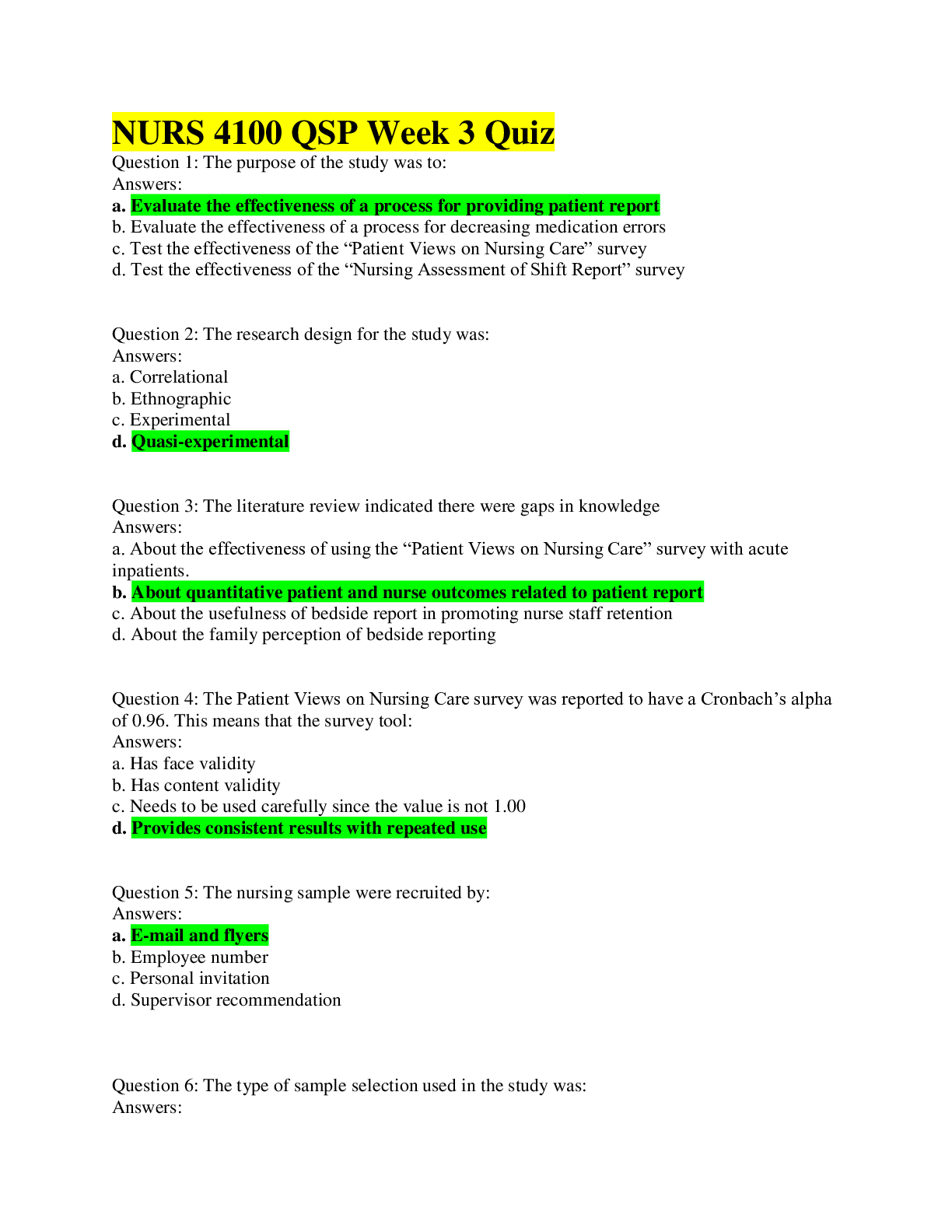Law > QUESTIONS & ANSWERS > CRIMINAL J 101 Assignment #1 Chapters 1-4 (160 points), Latest 2019/2020. (All)
CRIMINAL J 101 Assignment #1 Chapters 1-4 (160 points), Latest 2019/2020.
Document Content and Description Below
CRIMINAL J 101 Assignment #1 Chapters 1-4 (160 points) Chapter 1: Crime and Policy: A Complex Problem 1. In the United States, how did the violent crime rate change from 1994 to 2010 (increa... se, decrease, stable)? 2. How do crime trends in Canada compare to crime trends in the United States? During the same time period, how do imprisonment trends in Canada compare to imprisonment trends in the United States? What do these trends suggest about the relationship between incarceration and crime rates? 3. How has the police-to-population ratio in the United States changed over time? How has the police-to-population ratio in Canada changed over time? What do these trends suggest about the relationship between the number of police and crime rates? 4. Why do some people think that legalizing abortion contributed to The Great American Crime Drop (explain the theory)? According to the author, is legalized abortion a convincing explanation for the drop in crime (yes or no, explain)? 5. Why do some people think that lead (or lead poisoning) contributed to The Great American Crime Drop (explain the theory)? According to the author, is lead a convincing explanation for the drop in crime (yes or no, explain)? 6. What are some examples of contextual factors that might influence the crime rate? (1) 7. What are some examples of criminal justice policies that might influence the crime rate? (1) 8. How has the resource crisis, caused by the economic recession that began in 2008, affected the criminal justice system (there are consequences for police, courts, prisons, etc.)? (2) 9. What is evidence-based crime policy? (1) According to the author, what is the first obstacle to developing effective crime policies? (1) 10. Why do some analysts believe that the United States has two crime problems? (1) 11. According to the author, compared to other countries, what makes the crime problem in the United States unique? (1) 12. What are some of the forces that have contributed to the imprisonment boom in the United States (there are several)? (2) 13. What has been the most serious criticism of Michelle Alexander’s book? (1) 14. African Americans represent what percent of the U.S. population? African Americans represent what percent of all people arrested for drug offenses? African Americans represent what percent of those convicted of drug crimes? African Americans represent what percent of those sentenced to prison? (2) 15. In 2011, what percent of whites reported using an illegal drug in the past month? What percent of African Americans reported using an illegal drug in the past month? Can difference in drug use explain why African Americans are more likely to be arrested, convicted, and imprisoned for drug use (yes or no)? (2) 16. Why is “war” the wrong metaphor for crime policies (two reasons)? (2) 17. What are some of the adverse effects of imprisonment on communities? (1) 18. How does the disenfranchisement rate for African Americans compare to the disenfranchisement rate of other Americans? (1) 19. With respect to his search for sensible and effective crime policies, what are the author’s ground rules? (2) 20. Why is the distinction between prevention and punishment misleading? (1) 21. With regard to crime reduction, what can we learn from public health (i.e., what was the basic point of the 2013 JAMA article)? (1) 22. What is conservative crime control theology (i.e., explain the conservative view of crime and punishment)? (2) 23. What is liberal crime control theology (i.e., explain the liberal view of crime and punishment)? (2 24. According to the author, what fact do conservatives refuse to face? What fact do liberals refuse to face? (1) 25. With respect to the rules, how are conservatives and liberals different? (1) 26. What is the difference between the substantive criminal law and criminal procedure? (1) 27. What is the difference between the crime control model and the due process model? (1) Chapter 2: Models of Criminal Justice 1. What two (2) attitudes dominate thinking about the administration of criminal justice (you should explain each attitude)? (2 points) 2. The new cynicism comes in what two (2) versions (you should explain each version)? (1) 3. What is the sober realism perspective? (1) 4. According to experts, what is the risk of arrest for drug dealers who average 1,000 drug deals per year? (1) 5. With regard to drunk driving, according to experts, what is the risk for being stopped for a breath test? (1) 6. What is the major shortcoming of the Crime Commission’s model of the criminal justice system? (1) 7. The wedding cake model emphasizes what two (2) points? (2) 8. Based on the wedding cake model, how are celebrity cases different from routine cases (the book mentions three ways that celebrity cases are different from routine cases)? (3) 9. According to the Bureau of Justice Statistics, what percent of criminal cases go to trial? What percent are settled by plea bargaining? (1) What two (2) conclusions can be drawn from statistics on school violence/victimization? (2) 10. The O.J. Simpson murder trial helped to create what two (2) myths about the criminal justice system? According to Bureau of Justice Statistics (BJS) data, why are these myths (i.e., what does the data show)? (2) 11. What are the four (4) layers of the wedding cake model of the criminal justice system? (2) 12. What five (5) factors do criminal justice officials use to define the seriousness of an offense? (2) 13. What is the courtroom work group? The process of the courtroom work group has what two (2) important consequences? (3 14. According to the author, why is the whole idea of plea bargaining misleading? (1) 15. What were the main findings of Ulmer’s study of sentencing in three Pennsylvania counties? (2 16. What is back-end sentencing? (1) 17. In general, how is prior record related to sentencing? (1) 18. In general, how does the victim-offender relationship impact criminal justice decision making? (1) 19. With regard to the wedding cake model of the criminal justice system, why are outcomes in the third layer less predictable than outcomes in the second level? (1) 20. What is the liberation hypothesis? (1). 21. What were the results of Spohn and Cederblom’s research on the liberation hypothesis? (1) 22. Do crime victims and criminal justice officials make the same distinctions about the seriousness of crimes (yes or no, explain)? (1) 23. Why does the prior relationship between the victim and offender present a major policy dilemma (i.e., explain the dilemma)? (1) 24. According to the author, is the criminal justice system too harsh or too lenient (explain)? (1) 25. According to a Sentencing Project report, why do most people believe that the criminal justice system is soft on crime (there are two reasons for this misperception)? (2) 1- 26. What does it mean that “the process is the punishment?” (1) 27. How can insisting on your rights increase the “punishment” that a defendant receives for breaking the law (examples)? (1) Chapter 3: The Going Rate 1. What is the going rate? (1 point) 2. How has the going rate changed over the last thirty to forty years? (1) 3. With regard to sentencing, what is the major change that has occurred since the 1960s? (1) 4. What is the main reason that cases are rejected by prosecutors? What is the second most important reason that cases are rejected by prosecutors? (2) 5. Why is the term “dismissal” misleading? (1) 6. What are the important policy implications of data on rejections and dismissals? 7. According to research, what is the main concern of the prosecutorial charging unit? 8. Sentencing by judges involves what two (2) basic decisions? 9. The decision making of judges has been affected by what changes in state and federal laws (there have been several important changes)? 10. How did average time served for prisoners change from 1990 to 2009? 11. How does the incarceration rate in the United States compare to the incarceration rate in the rest of the world (e.g., higher or lower)? 12. According to the author, what is the main reason for the high incarceration rate in the United States? 13. With respect to sending persons convicted of major felonies to prison, is the United States more punitive than other countries (yes or no)? 14. With respect to time served, is the United States more punitive than other countries (yes or no)? 15. How does “visibility” (low visibility vs. high visibility) influence decision making (i.e., how does visibility limit discretion and increase accountability)? 16. What is an adversarial system of justice? What is an inquisitorial system of justice? 17. What is an administrative system of justice? Why does the author believe that we have an administrative system of justice (i.e., what are some examples that illustrate our administrative system of justice)? 18. According to research, are heavy caseloads the main cause of plea bargaining and the major cause of court delays (yes or no, explain)? 19. According to the author, can the courtroom work group limit reform (yes or no, explain)? 20. Why are some reforms successfully implemented and others are not (there are at least two reasons)? 21. What is the author’s law of criminal justice thermodynamics? What is an important corollary to the author’s law of criminal justice thermodynamics? 22. How does the death penalty illustrate the law of criminal justice thermodynamics (and the corollary)? 23. By 2012, how many convicted offenders had been exonerated as a result of DNA testing? On average, how long did these innocent people serve in prison before being released? 24. What are the main causes of wrongful convictions (e.g., what percent of wrongful convictions involve erroneous eyewitness identification)? (2) 25. What percent of those exonerated by the Innocent Project involved African Americans? (1) 26. How can the courtroom working group contribute to wrongful conviction? (1) 27. According to research by Huff and his colleagues, how often do errors occur in felony cases? 28. According to the Urban Institute, how common are wrongful convictions (i.e., what is the high estimate? What is the low estimate?)? 29. Why is the concept of the going rate important (two reasons)? (2) Chapter 4: The Prediction Problem 1. With respect to risk/needs factors, what is the difference between dynamic factors and static factors? (1 point) 2. What was the principal finding of the Wolfgang Cohort Study 3. What percent of Wolfgang’s original cohort were considered chronic delinquents? (1) 4. What is the main limitation of Wolfgang’s Cohort Study? 5. Wolfgang’s Cohort Study highlighted what three (3) important patterns in delinquency? 6. What are the policy implications of Wolfgang’s study? Why are the results of Wolfgang’s study relevant for both liberals and conservatives? 7. Have Wolfgang’s original findings been confirmed by other cohort studies (yes or no)? (1) 8. What is a criminal career? What is a career criminal? (2) 9. What is prevalence? What is frequency? 10. What is onset? What is persistence? What is desistence? What is career length? 11. What are some of the specific policies inspired by criminal career research? 12. What is the basic challenge confronting any policy directed toward career criminals? (1) 13. In the real world of criminal justice, career criminal programs run into what two (2) serious problems? 14. What are the three (3) basic methods for predicting criminal behavior (you should briefly explain each method)? (3) 15. When attempting to predict future offending, what is a true positive? What is a false negative? What is a false positive? 16. If we focus narrowly on identifying and locking up violent offenders, how successful is the instrument used in the Wenk study? 17. In the Texas death row inmate study, how often were predictions of dangerousness wrong? 18. What is the problem with the Sentencing Commission study of criminal history and recidivism? 19. The prediction device used in the Rand selective incapacitation study was accurate in what percent of cases? 20. In what percent of cases was the Rand prediction device grossly wrong? In what percent of cases was the Rand prediction device moderately wrong? 21. In a second study conducted by Rand (Why the High Rate Offenders are Hard to Predict), what did the authors conclude about predicting high rate offenders using arrest rates? 22. What is a critically important problem in translating career criminal research into crime policy? What are the important practical ramifications of this problem? 23. What is lambda? What can we expect if lambda is high? What can we expect if lambda is low? How much do estimates of lambda vary? 24. In conclusion, what does research on the prediction problem indicate? (2) [Show More]
Last updated: 1 year ago
Preview 1 out of 11 pages
Instant download
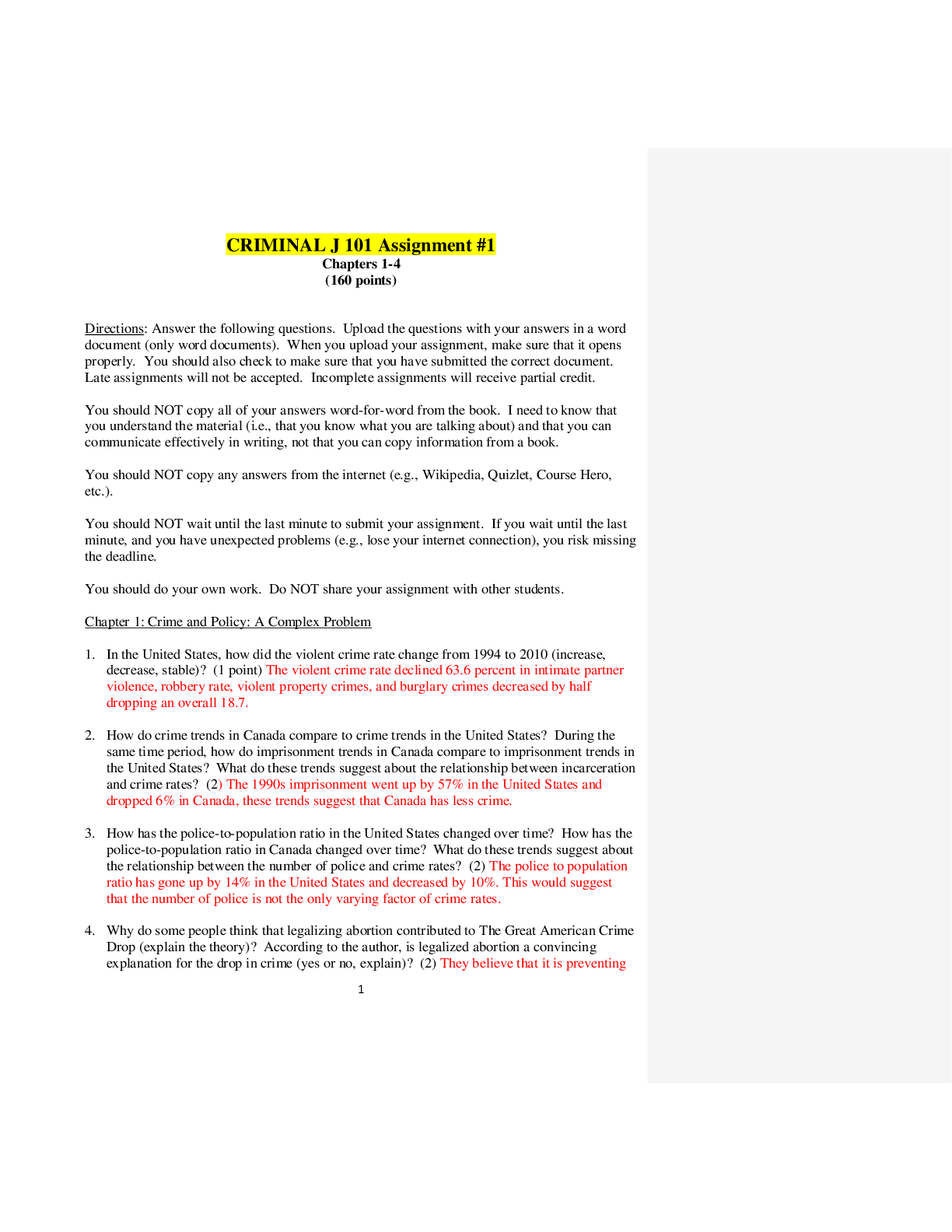
Buy this document to get the full access instantly
Instant Download Access after purchase
Add to cartInstant download
Reviews( 0 )
Document information
Connected school, study & course
About the document
Uploaded On
Apr 10, 2020
Number of pages
11
Written in
Additional information
This document has been written for:
Uploaded
Apr 10, 2020
Downloads
0
Views
38

.png)



